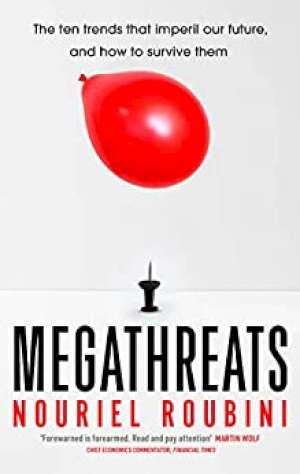26 April 2023
Megathreats
The ten trends that imperil our future, and how to survive them
Nouriel Roubini
2022, John Murray, 295 pages,
ISBN 9781529373776
Reviewer: Kevin Gardiner, Rothschild & Co/Cardiff Capital Region Econ Growth Partnership

Roubini is famous for calling the crash of 2008. Modestly, he does not call our attention to the many other crashes he has called. This new book argues that we face ten overlapping “megathreats”, with no happy ever after. One day soon, he says, something very bad will happen.
To summarise the plot: there is too much debt; there are too many old people; policy is badly designed; there is an Easy Money trap; the dollar is doomed; stagflation is unavoidable (and confusingly presents another eleven “potential” megathreats itself); globalisation will reverse; robots will destroy jobs; a new Cold War is at hand; and the planet may become uninhabitable.
I have pondered these topics and was keen to see what I’d missed. Alas, the book is largely a polemical rehash of recent history, media commentary and third-party comments. It is long on assertion, and short on analysis. There are no equations, which is good, but there are no charts or tables either.
I do agree with Roubini in several respects. Central banks have indeed been guilty in recent years of groupthink, and of “mission creep”. As he suggests, they have neither the expertise nor the mandate to discuss inequality and the environment, for example.
I share his view that recent low inflation was not “bad” disinflation, and that if inflation now falls back, policy rates don’t need to follow it fully. Today’s cryptocurrencies likely are an expensive blind alley. And the risk of another Cold War is real and does deserve to be described as a “megathreat”.
But the implications of debt, for example, are much more nuanced than he suggests. On the aging threat he is just wrong: like many pundits, he confuses demography with dependency. The dollar does not look that fragile, and the renminbi cannot easily replace it anyway. Stagflation is not a done deal. Faster processing speed is not artificial intelligence, though again, Roubini is not alone in confusing the two. On the more convincing megathreat – US-China tension – he is superficial and focuses more on waffle about Thucydides than on the status of Taiwan. He dismisses the possibility of adaptation to climate change almost out of hand.
The book is muddled, repetitive, and the author seems incapable of seeing anything positively. He talks a lot about human welfare, but barely mentions that unemployment rates for real people recently have been at generational lows.
I felt as if the care with which I was reading it exceeded the care with which it had been written. There are numerous small errors, as well as the bigger ones. For example: Milton Friedman’s Nobel Prize was not primarily for his critique of the Phillips curve; independent central banking and inflation targeting did not begin in the 1970s; there are not usually five defining characteristics of money; “Martin” Bailey is not in charge of UK monetary policy; Oscar Wilde did not describe “a snob as someone who knows the price of everything but the value of nothing”. The blurbs on the dust jacket are baffling.
It is not a book I can recommend, then. But it should probably be seen in context. Like many macroeconomists, Roubini is in the public relations game, but to his credit is not sheltering on a corporate payroll. This is celebrity economics, by “Doctor Doom”. And its shortcomings do not mean he will be wrong, of course: the future is a great leveller.
Reviewing it did provide an epiphany of sorts. The world is indeed complex, paradoxical, absurd and, yes, dangerous. But the degree of alarm we communicate as we come to terms with it of course reflects not just the world itself, but also our powers of perception – where we each stand in Plato’s cave – and articulation.
